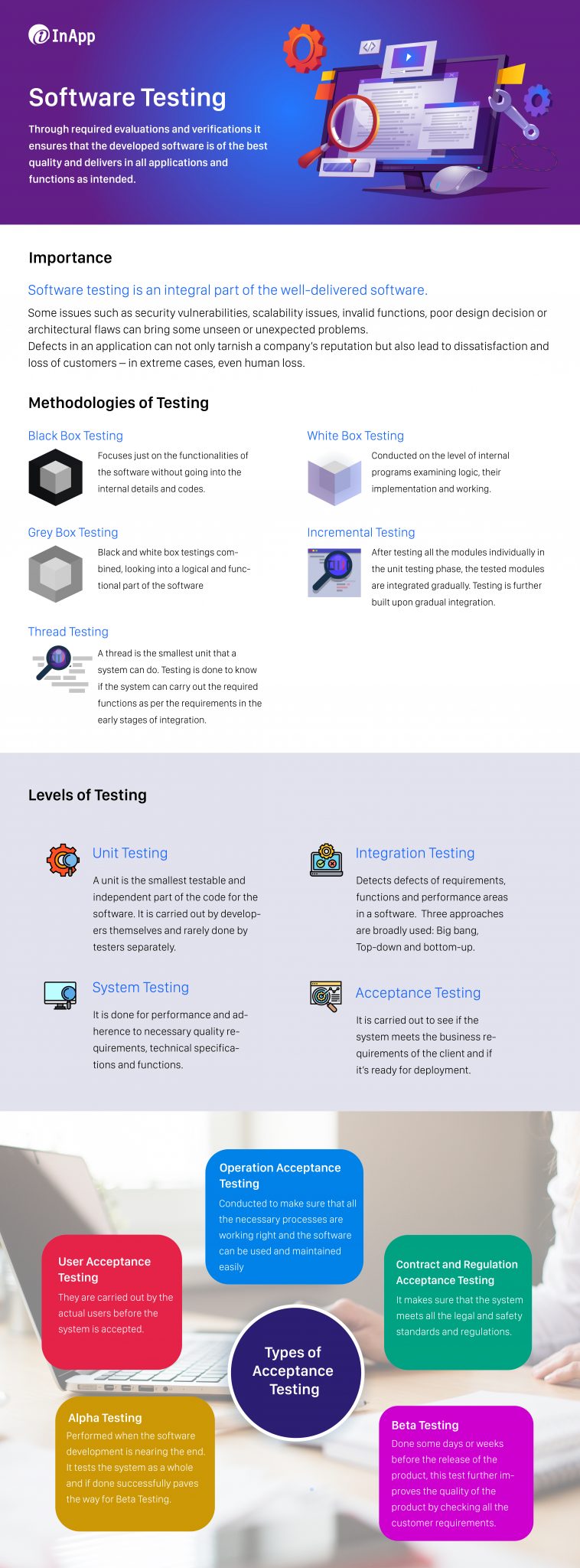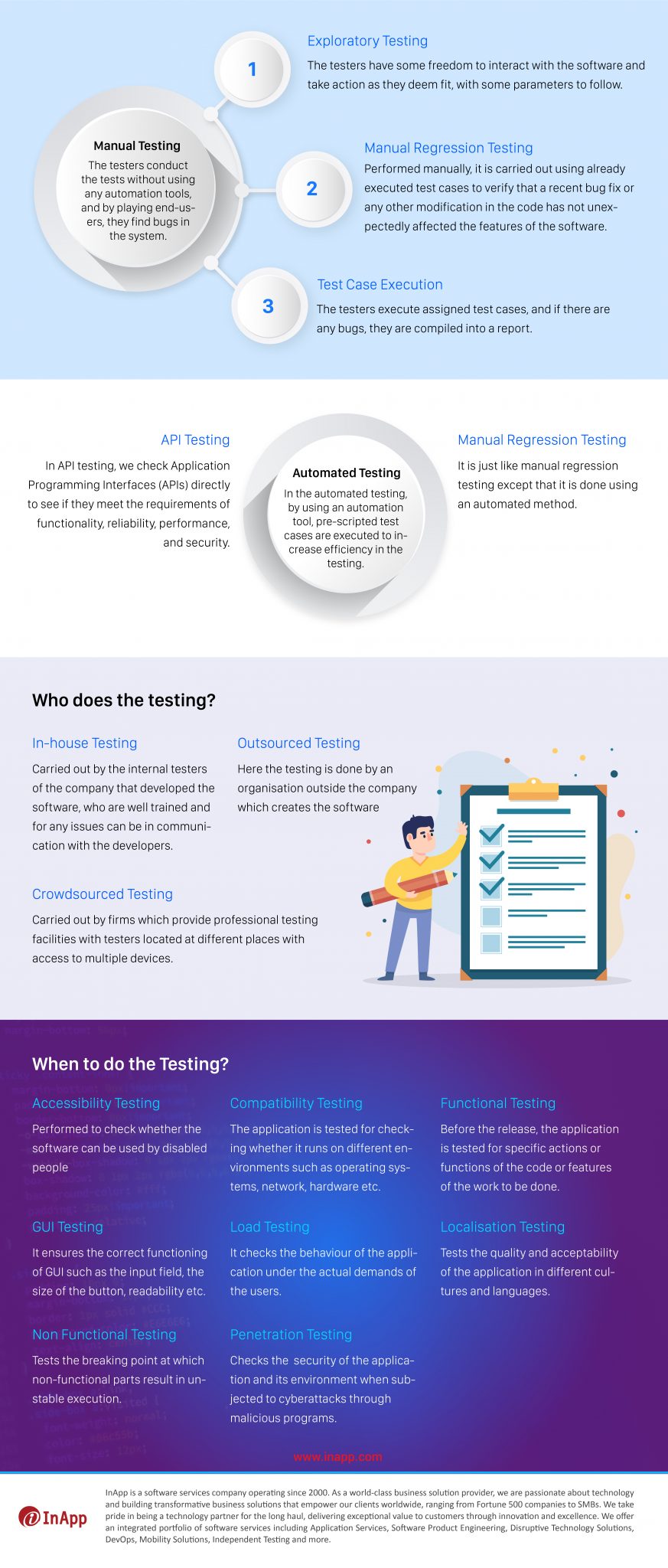To prevent unexpected problems during the real-world use of any software, it is of utmost importance to test them carefully using appropriate software testing types. In the software industry, independent software testing and quality assurance are of critical significance. The software testing life cycle for an application depends on the application and type. An application can be subjected to scores of software testing before finally being used by end-users. InApp infographic gives an easily understandable overview of different software testing tools and software testing approaches.
Independent Software Testing – Through required evaluations and verifications, it ensures that the developed software is of the best quality and delivers all applications and functions as intended.
What is the Importance of Software Testing?
Software testing is an integral part of well-delivered software.
Issues such as security vulnerabilities, scalability issues, invalid functions, poor design decisions, or architectural flaws can bring some unseen or unexpected problems.
Defects in an application can tarnish a company’s reputation and lead to dissatisfaction and loss of customers – in extreme cases, even human loss.
What are the Methodologies of Software Testing?
- Black Box Testing: Focuses just on the functionalities of the software without going into the internal details and codes.
- White Box Testing: Conducted on internal programs examining logic, implementation, and working.
- Grey Box Testing: Black and white box testings combined, looking into a logical and functional part of the software
- Incremental Testing: After testing all the modules individually in the unit testing phase, the tested modules are integrated gradually. Testing is further built upon gradual integration.
- Thread Testing: A thread is the smallest unit that a system can do. Testing is done to know if the system can carry out the required functions as per the requirements in the early stages of integration.
What are the levels of Testing?
- Unit Testing: A unit is the smallest testable and independent part of the code for the software. It is carried out by developers themselves and rarely done by testers separately.
- Integration Testing: Detects defects of requirements, functions, and performance areas in the software. Three approaches are broadly used: Big bang, Top-down, and bottom-up.
- System Testing: It is done for performance and adherence to necessary quality requirements, technical specifications, and functions.
- Acceptance Testing: It is carried out to see if the system meets the client’s business requirements and if it’s ready for deployment.
What are the types of Acceptance Testing?
- User Acceptance Testing: These are carried out by the actual users before the system is accepted.
- Operation Acceptance Testing: Conducted to ensure that all the necessary processes are working right and the software can be used and maintained easily.
- Contract and Regulation Acceptance Testing: It makes sure that the system meets all the legal and safety standards and regulations.
- Alpha Testing: Performed when the software development is nearing the end. It tests the system as a whole and, if done successfully, paves the way for Beta Testing.
- Beta Testing: Done some days or weeks before the product’s release, this test further improves the quality of the product by checking all the customer requirements.
What are the types of Manual Testing?
The testers conduct the tests without using any automation tools, and by playing end-users, they find bugs in the system.
- Exploratory Testing: The testers have some freedom to interact with the software and take action as they deem fit, with some parameters to follow.
- Manual Regression Testing: Performed manually, it is carried out using already executed test cases to verify that a recent bug fix or any other modification in the code has not unexpectedly affected the software’s features.
- Test Case Execution: The testers execute assigned test cases, and if there are any bugs, they are compiled into a report.
What are the types of Automated Testing?
In automated testing, pre-scripted test cases are executed by using an automation tool to increase efficiency in the testing.
API Testing: In API testing, we check Application Programming Interfaces (APIs) directly to see if they meet the requirements of functionality, reliability, performance, and security.
Automated Regression Testing: It is just like manual regression testing except that it is done using an automated method.
Who performs the software testing?
In-house Testing: Carried out by the internal testers of the company that developed the software, who are well trained and for any issues can be in communication with the developers.
Outsourced Testing: Here, the testing is done by an organization outside the company which creates the software
Crowdsourced Testing: Carried out by firms that provide professional testing facilities with testers located at different places with access to multiple devices.
When should different software tests be done?
Accessibility Testing: Performed to check whether disabled people can use the software
Compatibility Testing: The application is tested for checking whether it runs on different environments such as operating systems, networks, hardware, etc.
Functional Testing: Before the release, the application is tested for specific actions or functions of the work’s code or features.
GUI Testing: It ensures the correct functioning of GUI, such as the input field, the size of the button, readability, etc.
Load Testing: It checks the behavior of the application under the actual demands of the users.
Localization Testing: Tests the quality and acceptability of the application in different cultures and languages.
Non-Functional Testing: Tests the breaking point at which non-functional parts result in unstable execution.
Penetration Testing: Checks the application’s security and its environment when subjected to cyberattacks through malicious programs.
Frequently Asked Questions
What are the types of software testing?
- Accessibility Testing
- Compatibility Testing
- Functional Testing
- GUI Testing
- Load Testing
- Localization Testing
- Non Functional Testing
- Penetration Testing


